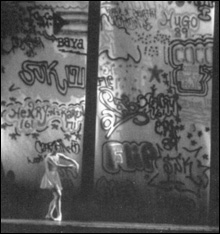EDITOR’S NOTE: Phoenix dance critic Marcia B. Siegel’s Howling Near Heaven: Twyla Tharp and the Reinvention of Modern Dance is now out from St. Martin’s Press. In the following excerpt, Marcia describes the incubation of Deuce Coupe.

NO JIVE: Eliot Feld’s ballet disappeared quickly, but Deuce Coupe became a landmark. |
Deuce Coupe was probably the first ballet accompanied by pop records. The Joffrey’s previous scores had included modern composers (Paul Creston, Lou Harrison, David Diamond), contemporary symphonic works with a jazz influence (Morton Gould), third-stream jazz (Kenyon Hopkins, Teo Macero), and the made-to-order rock of Astarte and Trinity. All of these had acceptably artistic dimensions. It was exactly the familiarity of the Beach Boys, their not being art, that was such an asset to Deuce Coupe. In his remarkable book about rock ’n’ roll, Mystery Train, the critic Greil Marcus notes the lack of condescension in certain American pop artists, who have “hoped, no matter how secretly, that their work would lift America to heaven, or drive a stake through its heart.” Marcus was launching a discussion about Randy Newman and the Beach Boys, but he might well have been describing Tharp.Deuce Coupe became a phenomenal hit, but it had a stressful incubation, right up to its premiere at Chicago’s Auditorium Theater on 8 February 1973. From the start of her discussions with Robert Joffrey, Tharp stipulated that her own company would dance in the work. This would be another first, for even in the legendary 1959 two-company encounter between Martha Graham and George Balanchine, Episodes, the modern dancers appeared in Graham’s dance, the ballet dancers in Balanchine’s with a token crossover dance in each piece (Sallie Wilson in Graham’s dance and Paul Taylor in Balanchine’s). Deuce Coupe was to be a fully integrated production, and this caused anxiety on both sides.
Tharp’s dancers were in awe of the Joffreys’ technical abilities. She broached the idea of the project to them before she took it on. [Isabel] Garcia-Lorca says: “I was not a strong technical dancer, which of course I knew better than anyone else. And being with these ballet dancers was a little daunting. A little scary.” [Kenneth] Rinker felt intimidated too, even though Tharp had already steered him into taking ballet class. He says: “I’m not a ballet dancer and never was and never wanted to be, but I tried to do it like I was.” The prospect of being seen in the City Center Joffrey context was irresistible to the Tharp dancers, though, and Tharp worked out most of the movement on them in her usual way before Joffrey rehearsals began.
 Related
Related:
Converging streams, Mastering the masterpieces, Terpsichore’s delight, More 
- Converging streams
The Alvin Ailey American Dance Theater offered two milestones in the development of contemporary dance during its annual Celebrity Series visit to the Wang Theatre last week.
- Mastering the masterpieces
It’s not exactly a trip down Memory Lane, but this weekend Boston Ballet is revisiting some pieces and choreographers it hasn’t performed in the Mikko Nissinen era.
- Terpsichore’s delight
Traveling troupes and local dancemakers spring up around the Boston area this season.
- L’Allegro, fuss and feathers, and the ICA blues
This year we were looking forward to dance performances at the Barbara Lee Family Foundation Theater in the new ICA.
- Pillow talk
There were baby ballerinas on screen and on stage for the first full weekend of Jacob’s Pillow 2006.
- New Orleans story
When the Royal Ballet touches down at the Wang Theatre this month, quash any visions you might have of tea-and-crumpets decorum.
- Decoding Balanchine
Nancy Goldner’s diminutive new book about George Balanchine’s choreography is deceptively readable.
- Balanchinean baubles
George Balanchine’s Jewels got a lukewarm critical reception when it premiered in 1967, though the public loved it right off for its triple-threat bravado.
- Weddings
Classical ballet is full of third-act weddings.
- Year in Dance: Reusable histories & durable trends
Conservation is a good thing in these times, and some of the most interesting performances drew on the uses of history — personal history, performance history, and even some inventions that sought to overturn history.
- State of the art
Maybe it’s the economy, but Boston Ballet’s third-annual season-opening gala was a sober evening, without the orchestral overture that graced the first two affairs.
- Less

 Topics
Topics:
Dance
, Entertainment, The Beach Boys, Sallie Wilson, More  , Entertainment, The Beach Boys, Sallie Wilson, Teo Macero, Dance, Performing Arts, Randy Newman, Ballet, George Balanchine, Paul Taylor, Less
, Entertainment, The Beach Boys, Sallie Wilson, Teo Macero, Dance, Performing Arts, Randy Newman, Ballet, George Balanchine, Paul Taylor, Less 